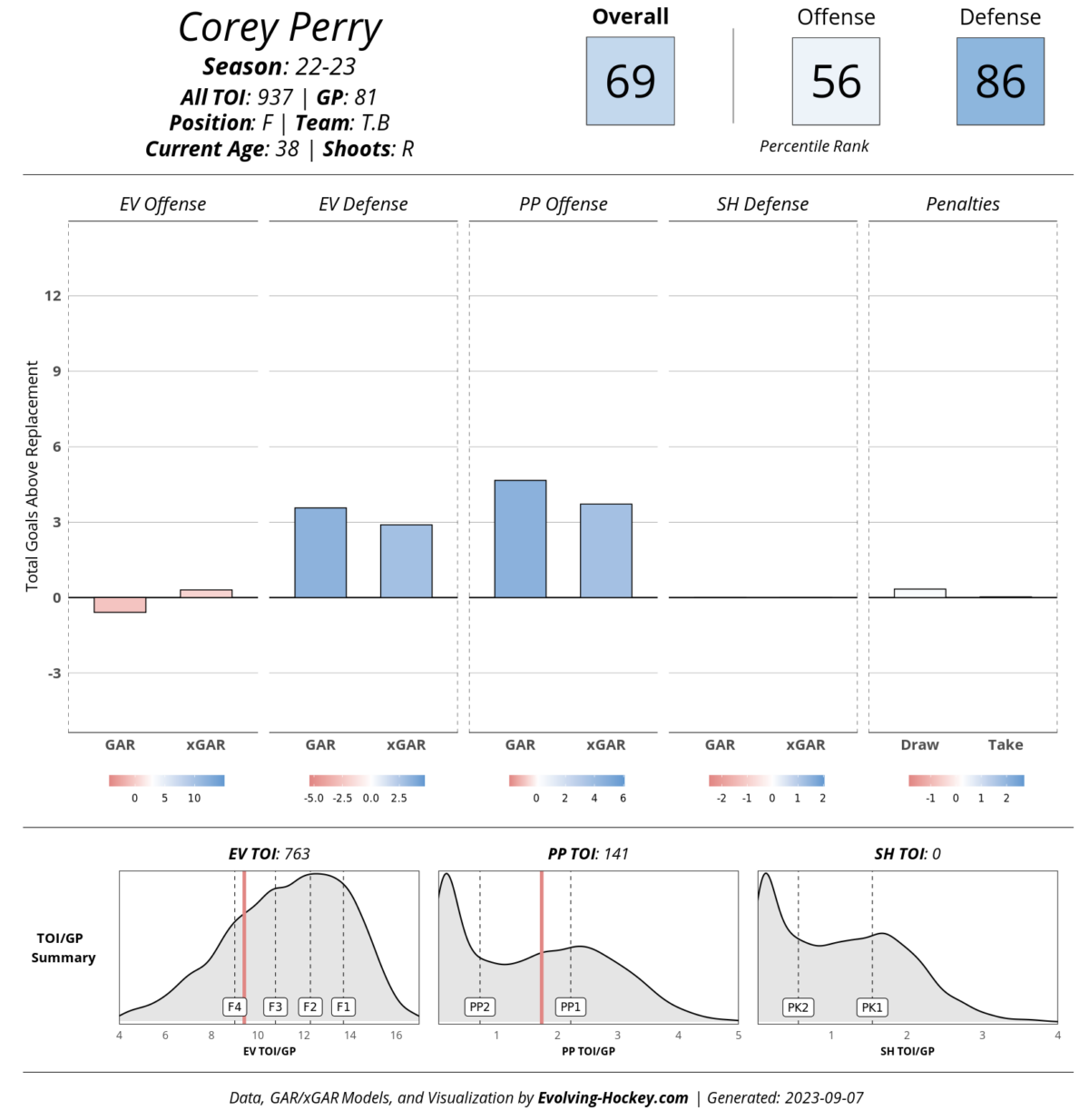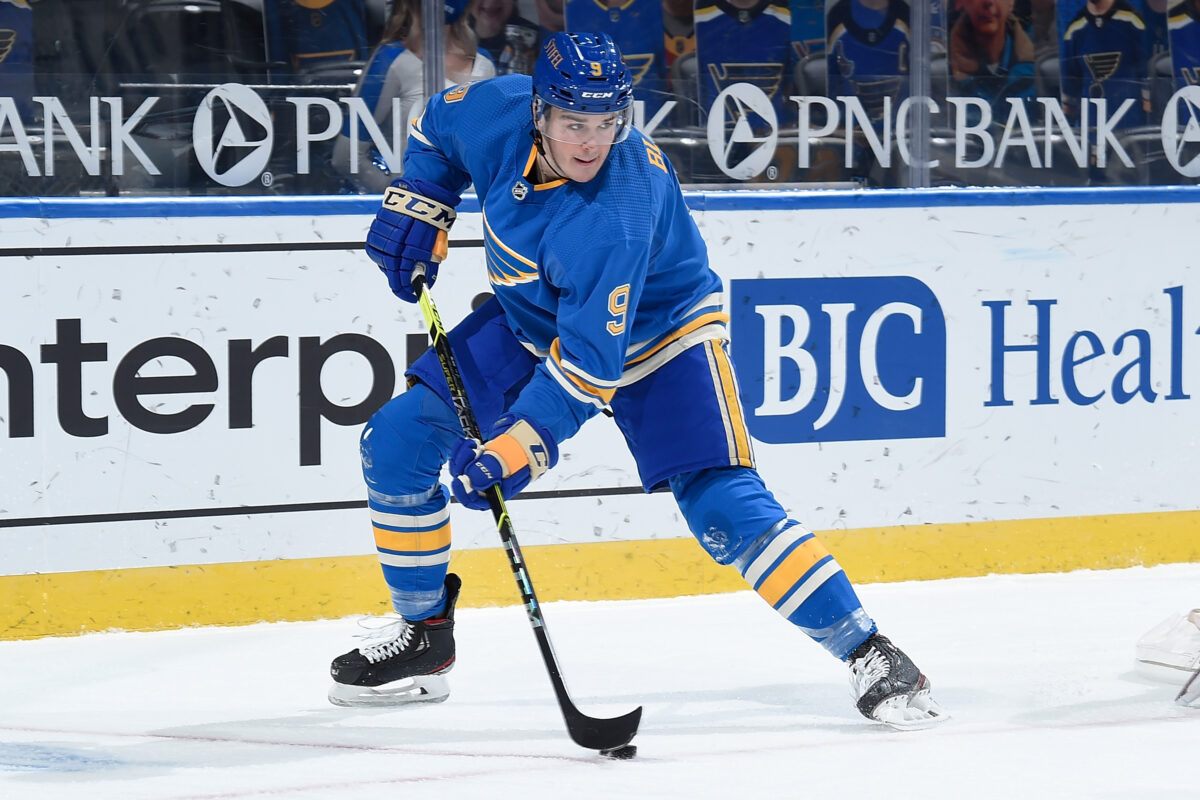The strength of the Buffalo Sabres’ lineup is held in the forward corps. Led by Tage Thompson and Dylan Cozens, their young core is among the best in the league, and with high-end talent in their prospect pool and the team’s depth up front, it should stay among the best in the NHL for a very long time.
With that said, and keeping in mind that the top-nine is very strong, there is room to improve on the fourth line of Kyle Okposo, Tyson Jost, and Zemgus Girgensons. That line was somewhat effective last season, posting just over a 51% expected goals share (xGF%), but the sample size was pretty small (160 minutes), and there’s no denying that the Sabres could upgrade on an individual level here.
Here’s a look at some potential trade deadline targets for the Sabres to shore up that line.
Corey Perry
He won’t make the Sabres any younger or faster, but Corey Perry has been an extremely effective bottom-six forward since he left the Anaheim Ducks in 2019. Since then, he has recorded four consecutive 20-plus point seasons, including a 19-goal, 40-point campaign with the Tampa Bay Lightning in 2021-22. He also has yet to sport an xGF% of under 50% in this time, proving his ability to handle tough assignments with success while only playing for about 13 minutes a night.
Perry is an excellent defensive forward, which the Sabres need, even on their fourth line. According to Evolving Hockey, he ranks in the 86th percentile for his even-strength defensive impact among all NHL forwards, without necessarily sacrificing offense for defense.

The Chicago Blackhawks will be vying for another lottery pick this season, and Perry, on a one-year deal, will be a sought-after bottom-six addition for any playoff contender come March. He won’t be needed for the power play or penalty kill, but his even-strength prowess against the opposition’s top lines speaks for itself and would be a valuable addition to the Sabres, as would his veteran experience in the event that the Sabres find themselves in a playoff position.
Perry will cost more than the average bottom-six player, partly because of his name and partly because he’s still a very effective player. I would anticipate him costing a mid-round pick and a B-level prospect – something like Viljami Marjala and a fourth-round pick would be fair value for the veteran.
Mike Hoffman
Despite publicly expressing his desire to play for the San Jose Sharks this season, Mike Hoffman could become a flippable player by March. For most of his career, he has played a top-nine role, and until the 2020-21 season, was a consistent 50-plus-point scorer. Expecting him to be in the bottom-six with the Sharks, his next squad, is a stretch. However, on a playoff team, the once-prolific winger should find himself on the bottom two lines.
To put it candidly, Hoffman’s analytical profile is bad. He’s only had one season in his career (2014-15) with an xGF% of over 50%, meaning that opposing teams (outside of that one season) have always earned more scoring chances than Hoffman’s team.
Despite that, he was once a perennial 25-plus goal scorer, which has since regressed to around 15 per season. On the fourth line, it’s hard to complain about the possibility of a 15-goal scorer who — albeit unlikely — could get on a hot streak and end up providing decent secondary scoring. He gives up a lot defensively, to be sure, but goals win games, and Hoffman is still capable of scoring in a depth role.
Acquiring Hoffman, in my opinion, wouldn’t cost a whole lot. He’s a shadow of his former self and gets paid much more than he should at $4.5 million. I would think that a late-round pick would be enough to acquire him.
Nicolas Aubé-Kubel
Where Hoffman would be an offense-only (and unlikely) addition to the fourth line, Washington Capitals forward Nicolas Aubé-Kubel is pretty much all defense. Last season, per Evolving Hockey, he ranked in the 80th percentile for his defensive impact, but in the 18th percentile at the other end of the ice.
Aubé-Kubel’s playstyle could also lend a helping hand on the penalty kill. He has extremely limited experience in man-down situations, but in his 10 minutes on the penalty kill in 2022-23, he posted an extraordinary xGF% of 44% — meaning that his team had almost as many scoring opportunities as the team on the power play.
Related: Buffalo Sabres’ Best Trade Deadline Additions
The real benefit of acquiring Aubé-Kubel, to me, is the cost. Whereas the two names above carry weight, he is a relatively unknown commodity around the NHL, and with a defense-first mentality and little scoring, his price should be lower. The Capitals should be looking to acquire any and all assets they possibly can, so even a sixth-round pick could entice them to let go of Aubé-Kubel.
Honorable Mentions
According to Evolving Hockey, Sammy Blais ranks in the 73rd percentile in defense and in the 41st offensively, making him a potentially fantastic bottom-six trade piece for the St. Louis Blues. At just $1 million, he has had success with the Blues in a middle-six role and should be a sought-after target in March.

The Nashville Predators are not expected to be in a playoff position, which likely means that some players are on the move — including Yakov Trenin. The defense-first winger is incredibly effective in his own end at both even strength and on the penalty kill and has shown potential as a depth goal scorer. The Sabres could look to add Trenin if they are in the market for a very physical addition to the fourth line.
The Sabres Will be Active
Buffalo should find itself in or close to a playoff position come March, so anticipate a lot of activity at the trade deadline. The Sabres are far more likely to add to the blue line than they are to their forward corps, but it might be in their best interest to look for players to spruce up their bottom-six, and more specifically their fourth line. Adding a defense-first player would probably be smarter than looking for depth scoring at the trade deadline, so Buffalo would be smart to consider cheaper options with a defensive impact backed up by analytics, rather than a player like Hoffman.
